Jiawei Zhang
Lost in Tokenization: Context as the Key to Unlocking Biomolecular Understanding in Scientific LLMs
Oct 27, 2025Abstract:Scientific Large Language Models (Sci-LLMs) have emerged as a promising frontier for accelerating biological discovery. However, these models face a fundamental challenge when processing raw biomolecular sequences: the tokenization dilemma. Whether treating sequences as a specialized language, risking the loss of functional motif information, or as a separate modality, introducing formidable alignment challenges, current strategies fundamentally limit their reasoning capacity. We challenge this sequence-centric paradigm by positing that a more effective strategy is to provide Sci-LLMs with high-level structured context derived from established bioinformatics tools, thereby bypassing the need to interpret low-level noisy sequence data directly. Through a systematic comparison of leading Sci-LLMs on biological reasoning tasks, we tested three input modes: sequence-only, context-only, and a combination of both. Our findings are striking: the context-only approach consistently and substantially outperforms all other modes. Even more revealing, the inclusion of the raw sequence alongside its high-level context consistently degrades performance, indicating that raw sequences act as informational noise, even for models with specialized tokenization schemes. These results suggest that the primary strength of existing Sci-LLMs lies not in their nascent ability to interpret biomolecular syntax from scratch, but in their profound capacity for reasoning over structured, human-readable knowledge. Therefore, we argue for reframing Sci-LLMs not as sequence decoders, but as powerful reasoning engines over expert knowledge. This work lays the foundation for a new class of hybrid scientific AI agents, repositioning the developmental focus from direct sequence interpretation towards high-level knowledge synthesis. The code is available at github.com/opendatalab-raise-dev/CoKE.
ReTrack: Data Unlearning in Diffusion Models through Redirecting the Denoising Trajectory
Sep 16, 2025Abstract:Diffusion models excel at generating high-quality, diverse images but suffer from training data memorization, raising critical privacy and safety concerns. Data unlearning has emerged to mitigate this issue by removing the influence of specific data without retraining from scratch. We propose ReTrack, a fast and effective data unlearning method for diffusion models. ReTrack employs importance sampling to construct a more efficient fine-tuning loss, which we approximate by retaining only dominant terms. This yields an interpretable objective that redirects denoising trajectories toward the $k$-nearest neighbors, enabling efficient unlearning while preserving generative quality. Experiments on MNIST T-Shirt, CelebA-HQ, CIFAR-10, and Stable Diffusion show that ReTrack achieves state-of-the-art performance, striking the best trade-off between unlearning strength and generation quality preservation.
Discovery Learning accelerates battery design evaluation
Aug 09, 2025Abstract:Fast and reliable validation of novel designs in complex physical systems such as batteries is critical to accelerating technological innovation. However, battery research and development remain bottlenecked by the prohibitively high time and energy costs required to evaluate numerous new design candidates, particularly in battery prototyping and life testing. Despite recent progress in data-driven battery lifetime prediction, existing methods require labeled data of target designs to improve accuracy and cannot make reliable predictions until after prototyping, thus falling far short of the efficiency needed to enable rapid feedback for battery design. Here, we introduce Discovery Learning (DL), a scientific machine-learning paradigm that integrates active learning, physics-guided learning, and zero-shot learning into a human-like reasoning loop, drawing inspiration from learning theories in educational psychology. DL can learn from historical battery designs and actively reduce the need for prototyping, thus enabling rapid lifetime evaluation for unobserved material-design combinations without requiring additional data labeling. To test DL, we present 123 industrial-grade large-format lithium-ion pouch cells, spanning eight material-design combinations and diverse cycling protocols. Trained solely on public datasets of small-capacity cylindrical cells, DL achieves 7.2% test error in predicting the average cycle life under unknown device variability. This results in savings of 98% in time and 95% in energy compared to industrial practices. This work highlights the potential of uncovering insights from historical designs to inform and accelerate the development of next-generation battery technologies. DL represents a key advance toward efficient data-driven modeling and helps realize the promise of machine learning for accelerating scientific discovery and engineering innovation.
AIGVE-MACS: Unified Multi-Aspect Commenting and Scoring Model for AI-Generated Video Evaluation
Jul 02, 2025Abstract:The rapid advancement of AI-generated video models has created a pressing need for robust and interpretable evaluation frameworks. Existing metrics are limited to producing numerical scores without explanatory comments, resulting in low interpretability and human evaluation alignment. To address those challenges, we introduce AIGVE-MACS, a unified model for AI-Generated Video Evaluation(AIGVE), which can provide not only numerical scores but also multi-aspect language comment feedback in evaluating these generated videos. Central to our approach is AIGVE-BENCH 2, a large-scale benchmark comprising 2,500 AI-generated videos and 22,500 human-annotated detailed comments and numerical scores across nine critical evaluation aspects. Leveraging AIGVE-BENCH 2, AIGVE-MACS incorporates recent Vision-Language Models with a novel token-wise weighted loss and a dynamic frame sampling strategy to better align with human evaluators. Comprehensive experiments across supervised and zero-shot benchmarks demonstrate that AIGVE-MACS achieves state-of-the-art performance in both scoring correlation and comment quality, significantly outperforming prior baselines including GPT-4o and VideoScore. In addition, we further showcase a multi-agent refinement framework where feedback from AIGVE-MACS drives iterative improvements in video generation, leading to 53.5% quality enhancement. This work establishes a new paradigm for comprehensive, human-aligned evaluation of AI-generated videos. We release the AIGVE-BENCH 2 and AIGVE-MACS at https://huggingface.co/xiaoliux/AIGVE-MACS.
Efficient Unified Caching for Accelerating Heterogeneous AI Workloads
Jun 14, 2025Abstract:Modern AI clusters, which host diverse workloads like data pre-processing, training and inference, often store the large-volume data in cloud storage and employ caching frameworks to facilitate remote data access. To avoid code-intrusion complexity and minimize cache space wastage, it is desirable to maintain a unified cache shared by all the workloads. However, existing cache management strategies, designed for specific workloads, struggle to handle the heterogeneous AI workloads in a cluster -- which usually exhibit heterogeneous access patterns and item storage granularities. In this paper, we propose IGTCache, a unified, high-efficacy cache for modern AI clusters. IGTCache leverages a hierarchical access abstraction, AccessStreamTree, to organize the recent data accesses in a tree structure, facilitating access pattern detection at various granularities. Using this abstraction, IGTCache applies hypothesis testing to categorize data access patterns as sequential, random, or skewed. Based on these detected access patterns and granularities, IGTCache tailors optimal cache management strategies including prefetching, eviction, and space allocation accordingly. Experimental results show that IGTCache increases the cache hit ratio by 55.6% over state-of-the-art caching frameworks, reducing the overall job completion time by 52.2%.
Population-Proportional Preference Learning from Human Feedback: An Axiomatic Approach
Jun 05, 2025

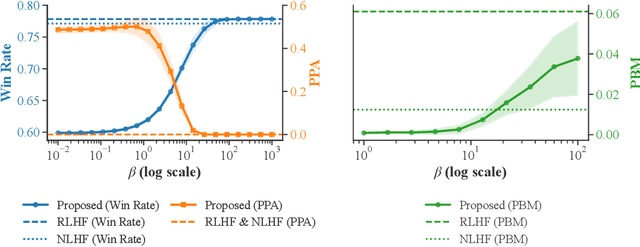

Abstract:Conventional preference learning methods often prioritize opinions held more widely when aggregating preferences from multiple evaluators. This may result in policies that are biased in favor of some types of opinions or groups. The objective of this paper is to develop a novel preference learning framework capable of aligning aggregate opinions and policies proportionally with the true population distribution of evaluator preferences. Our approach infers the feasible set of evaluator population distributions directly from pairwise comparison data. Using these estimates, the algorithm constructs a policy that satisfies foundational axioms from social choice theory, namely monotonicity and Pareto efficiency, as well as our newly-introduced axioms of population-proportional representation and population-bounded robustness. We propose a soft-max relaxation method that smoothly trade-offs population-proportional representation with the selection of the Condorcet winner (which beats all other options in pairwise comparisons). Finally, we validate the effectiveness and scalability of our approach through experiments on both tabular recommendation tasks and large-scale language model alignment.
On the Convergence Analysis of Muon
May 29, 2025Abstract:The majority of parameters in neural networks are naturally represented as matrices. However, most commonly used optimizers treat these matrix parameters as flattened vectors during optimization, potentially overlooking their inherent structural properties. Recently, an optimizer called Muon has been proposed, specifically designed to optimize matrix-structured parameters. Extensive empirical evidence shows that Muon can significantly outperform traditional optimizers when training neural networks. Nonetheless, the theoretical understanding of Muon's convergence behavior and the reasons behind its superior performance remain limited. In this work, we present a comprehensive convergence rate analysis of Muon and its comparison with Gradient Descent (GD). We further characterize the conditions under which Muon can outperform GD. Our theoretical results reveal that Muon can benefit from the low-rank and approximate blockwise diagonal structure of Hessian matrices -- phenomena widely observed in practical neural network training. Our experimental results support and corroborate the theoretical findings.
An Arbitrary-Modal Fusion Network for Volumetric Cranial Nerves Tract Segmentation
May 05, 2025Abstract:The segmentation of cranial nerves (CNs) tract provides a valuable quantitative tool for the analysis of the morphology and trajectory of individual CNs. Multimodal CNs tract segmentation networks, e.g., CNTSeg, which combine structural Magnetic Resonance Imaging (MRI) and diffusion MRI, have achieved promising segmentation performance. However, it is laborious or even infeasible to collect complete multimodal data in clinical practice due to limitations in equipment, user privacy, and working conditions. In this work, we propose a novel arbitrary-modal fusion network for volumetric CNs tract segmentation, called CNTSeg-v2, which trains one model to handle different combinations of available modalities. Instead of directly combining all the modalities, we select T1-weighted (T1w) images as the primary modality due to its simplicity in data acquisition and contribution most to the results, which supervises the information selection of other auxiliary modalities. Our model encompasses an Arbitrary-Modal Collaboration Module (ACM) designed to effectively extract informative features from other auxiliary modalities, guided by the supervision of T1w images. Meanwhile, we construct a Deep Distance-guided Multi-stage (DDM) decoder to correct small errors and discontinuities through signed distance maps to improve segmentation accuracy. We evaluate our CNTSeg-v2 on the Human Connectome Project (HCP) dataset and the clinical Multi-shell Diffusion MRI (MDM) dataset. Extensive experimental results show that our CNTSeg-v2 achieves state-of-the-art segmentation performance, outperforming all competing methods.
Rethinking Time Encoding via Learnable Transformation Functions
May 01, 2025Abstract:Effectively modeling time information and incorporating it into applications or models involving chronologically occurring events is crucial. Real-world scenarios often involve diverse and complex time patterns, which pose significant challenges for time encoding methods. While previous methods focus on capturing time patterns, many rely on specific inductive biases, such as using trigonometric functions to model periodicity. This narrow focus on single-pattern modeling makes them less effective in handling the diversity and complexities of real-world time patterns. In this paper, we investigate to improve the existing commonly used time encoding methods and introduce Learnable Transformation-based Generalized Time Encoding (LeTE). We propose using deep function learning techniques to parameterize non-linear transformations in time encoding, making them learnable and capable of modeling generalized time patterns, including diverse and complex temporal dynamics. By enabling learnable transformations, LeTE encompasses previous methods as specific cases and allows seamless integration into a wide range of tasks. Through extensive experiments across diverse domains, we demonstrate the versatility and effectiveness of LeTE.
Frequency-domain Learning with Kernel Prior for Blind Image Deblurring
Apr 20, 2025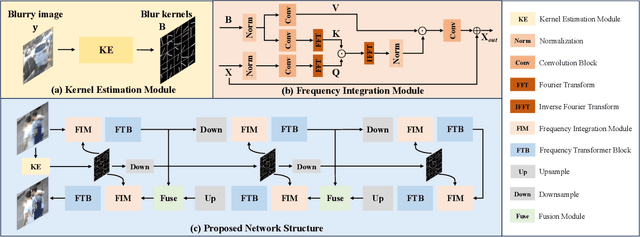
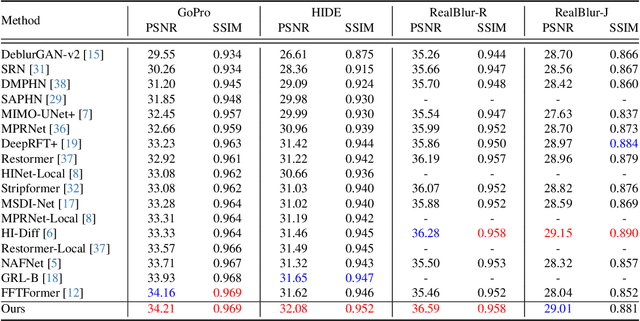
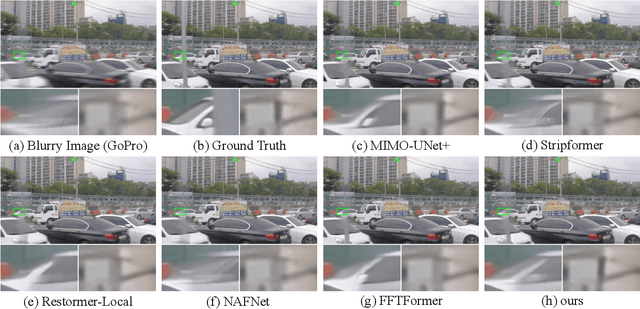
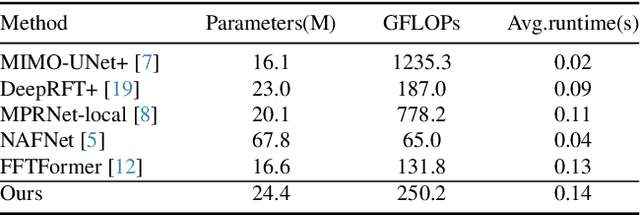
Abstract:While achieving excellent results on various datasets, many deep learning methods for image deblurring suffer from limited generalization capabilities with out-of-domain data. This limitation is likely caused by their dependence on certain domain-specific datasets. To address this challenge, we argue that it is necessary to introduce the kernel prior into deep learning methods, as the kernel prior remains independent of the image context. For effective fusion of kernel prior information, we adopt a rational implementation method inspired by traditional deblurring algorithms that perform deconvolution in the frequency domain. We propose a module called Frequency Integration Module (FIM) for fusing the kernel prior and combine it with a frequency-based deblurring Transfomer network. Experimental results demonstrate that our method outperforms state-of-the-art methods on multiple blind image deblurring tasks, showcasing robust generalization abilities. Source code will be available soon.
 Add to Chrome
Add to Chrome Add to Firefox
Add to Firefox Add to Edge
Add to Edge